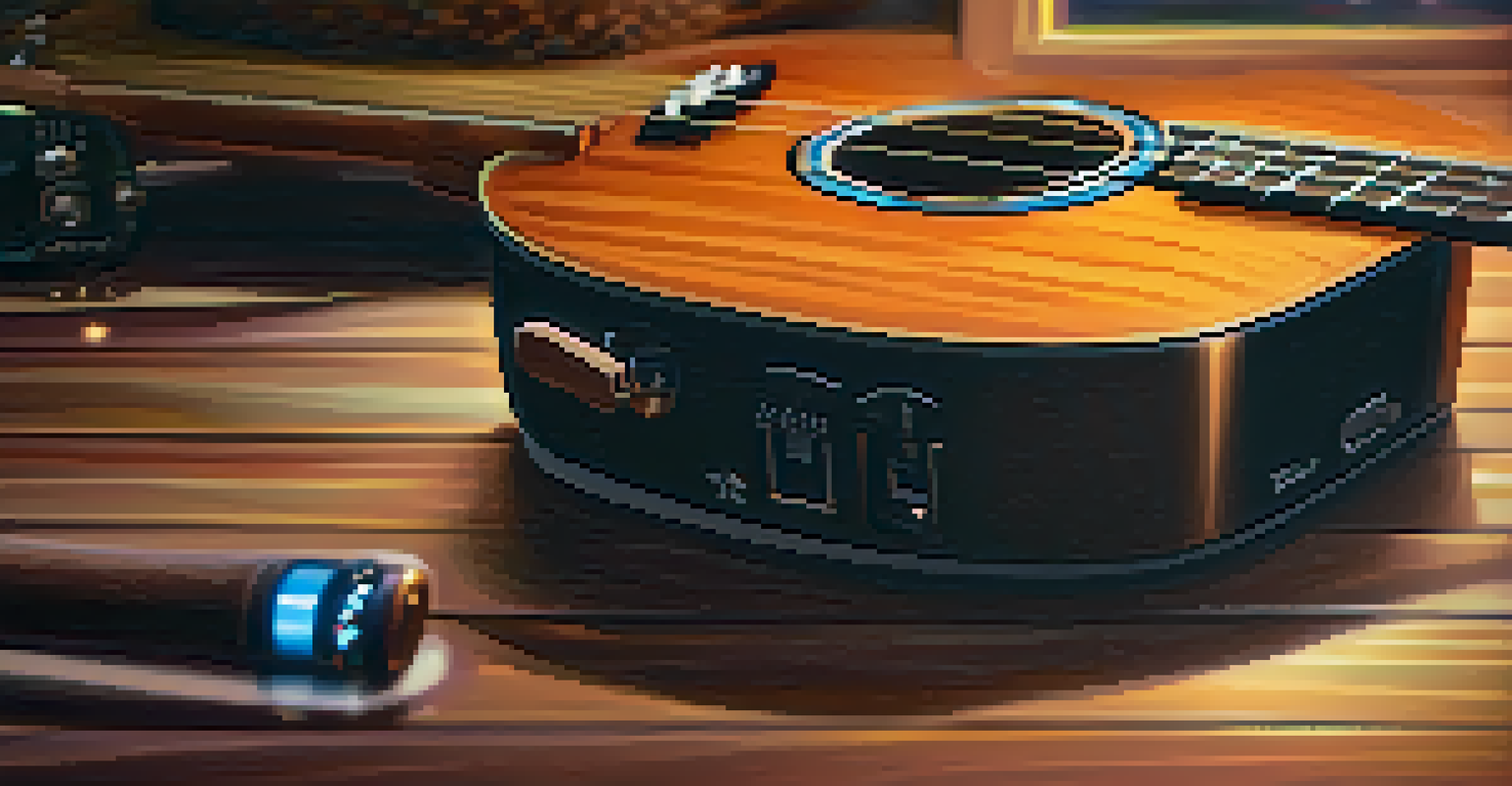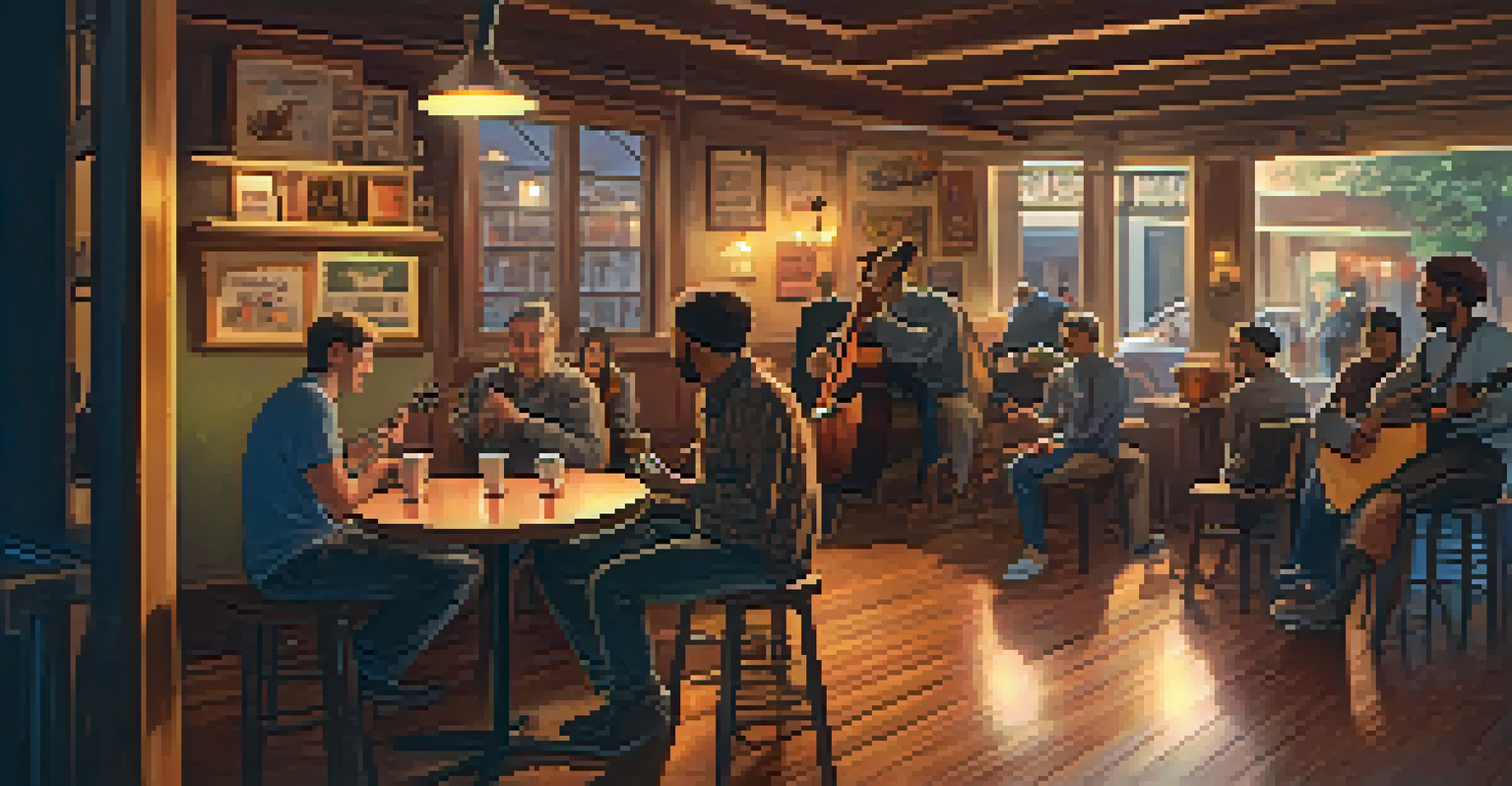Loop Pedals and Ukulele: A New Era of Performance Techniques

What Are Loop Pedals and How Do They Work?
Loop pedals are electronic devices that allow musicians to record and layer sounds in real time. Imagine it as a magical tool that lets you play multiple instruments at once, all by yourself! When you press the pedal, it captures your sound and plays it back on repeat, allowing you to build complex musical arrangements on the fly.
Music can change the world because it can change people.
For example, a ukulele player can strum a catchy chord progression, hit the pedal, and then add a melody on top. This creates a rich, full sound that can be mesmerizing to audiences. Loop pedals are particularly appealing for solo artists, as they can create an entire performance without needing a band.
The beauty of loop pedals lies in their versatility; they can be used for various genres, from folk to pop and even jazz. By layering sounds, artists can explore new creative avenues, pushing the boundaries of traditional ukulele playing.
Why Ukulele and Loop Pedals Make a Perfect Match
The ukulele’s light, cheerful sound pairs beautifully with the layering capabilities of loop pedals. When you add a loop pedal to your ukulele, you essentially open up a world of creative possibilities. It's like adding sprinkles to ice cream—suddenly, your performance is more vibrant and exciting!

Many musicians appreciate the ukulele for its accessibility, and combining it with a loop pedal makes it even more inviting. Players can experiment with harmonies and rhythms, creating unique soundscapes that captivate audiences. This combination has led to an explosion of creativity in live performances and recordings alike.
Loop Pedals Enhance Musical Creativity
Using loop pedals allows musicians to layer sounds and create rich compositions in real time.
Moreover, the portable nature of the ukulele means you can easily take it anywhere, making it a fantastic companion for loop pedals. Whether you're busking on the street or performing at a local café, the duo can create an engaging musical experience that draws people in.
Getting Started with Loop Pedals for Ukulele
If you’re excited to try loop pedals with your ukulele, starting is easier than you might think! First, you'll need to choose a loop pedal that fits your needs. There are many options available, from simple models to more advanced ones with multiple tracks and effects, so do a bit of research to find the right fit for you.
Creativity takes courage.
Once you have your pedal, the next step is to practice layering sounds. Start with a basic strumming pattern, then gradually add melodies or vocal harmonies. It might feel a bit awkward at first, but like learning any new technique, practice makes perfect. Soon you’ll be crafting intricate compositions that showcase your unique style.
Don't forget to experiment! Loop pedals allow for endless creativity, so play around with different sounds and effects until you find what resonates with you. The goal is to have fun while exploring the new dimensions your ukulele can reach.
Incorporating Effects: Enhancing Your Sound
One of the exciting aspects of using loop pedals is the ability to incorporate various effects. Imagine adding reverb for a dreamy sound or delay for an echoing effect—it can truly elevate your performance. These effects can help create ambiance and depth, making your music even more engaging for listeners.
For instance, a light distortion can give your ukulele a punchier sound, allowing it to cut through the mix. You could also use modulation effects to create a shimmering quality that adds a layer of richness. Exploring these effects can transform your music from simple melodies to intricate soundscapes.
Ukulele and Loop Pedals: A Perfect Pair
The cheerful sound of the ukulele combined with loop pedals opens up exciting creative possibilities for musicians.
As you become more comfortable with your loop pedal, experimenting with different effects will enhance your creative expression. Remember, the key is to find the right balance; too many effects can muddy your sound, while the right ones can perfectly complement your ukulele’s tone.
Live Performance Tips with Loop Pedals
Performing live with a loop pedal can be thrilling but also a bit daunting. One essential tip is to practice your setlist thoroughly. Familiarize yourself with the songs and transitions to ensure a smooth performance. Think of it like preparing for a big game—you want to be ready to showcase your skills without any hiccups.
Another helpful tip is to engage with your audience while performing. Loop pedals allow for more dynamic performances, so use that to your advantage! You might invite the crowd to clap along or sing harmonies, creating an interactive experience that draws everyone in.
Finally, be prepared for technical issues. Loop pedals, like any electronic gear, can sometimes malfunction. Stay calm and have a backup plan, whether it's an acoustic set or a simple unplugged performance. Being adaptable is key to ensuring your live shows remain enjoyable, regardless of any hiccups.
Exploring Genres: The Versatility of Ukulele and Loop Pedals
The combination of ukulele and loop pedals isn’t limited to just one genre; it opens doors to explore a variety of musical styles. From reggae grooves to soulful ballads, the possibilities are endless. This versatility allows musicians to express themselves in ways that might not have been possible before.
For example, a player might use a loop pedal to create a jazzy rhythm while adding ukulele solos on top. Alternatively, you could layer folk melodies with modern pop beats, creating a unique fusion that captures listeners' attention. This blend of styles is what makes performances so captivating.
Embrace Versatility Across Genres
Loop pedals enable ukulele players to explore a wide range of musical styles, from reggae to jazz, enhancing their artistic expression.
As you experiment, you may find your own unique voice within different genres. Don’t be afraid to mix and match elements from various styles—this is where creativity thrives, and your music can truly shine.
The Future of Ukulele Performance with Loop Pedals
Looking ahead, the integration of loop pedals with ukulele performances is set to grow even more popular. As technology advances, musicians are finding new ways to innovate and push the boundaries of their art. This trend is likely to inspire a new generation of ukulele players to explore their creativity.
Moreover, the rise of social media platforms allows artists to share their loop pedal creations with a global audience. This exposure encourages collaboration and experimentation, leading to fresh sounds and unique performances. It's an exciting time to be part of this musical evolution!

In conclusion, loop pedals are transforming the way ukulele is performed, offering endless possibilities for artistic expression. Whether you're a seasoned musician or a beginner, embracing this technology can open new doors and elevate your performances to new heights.